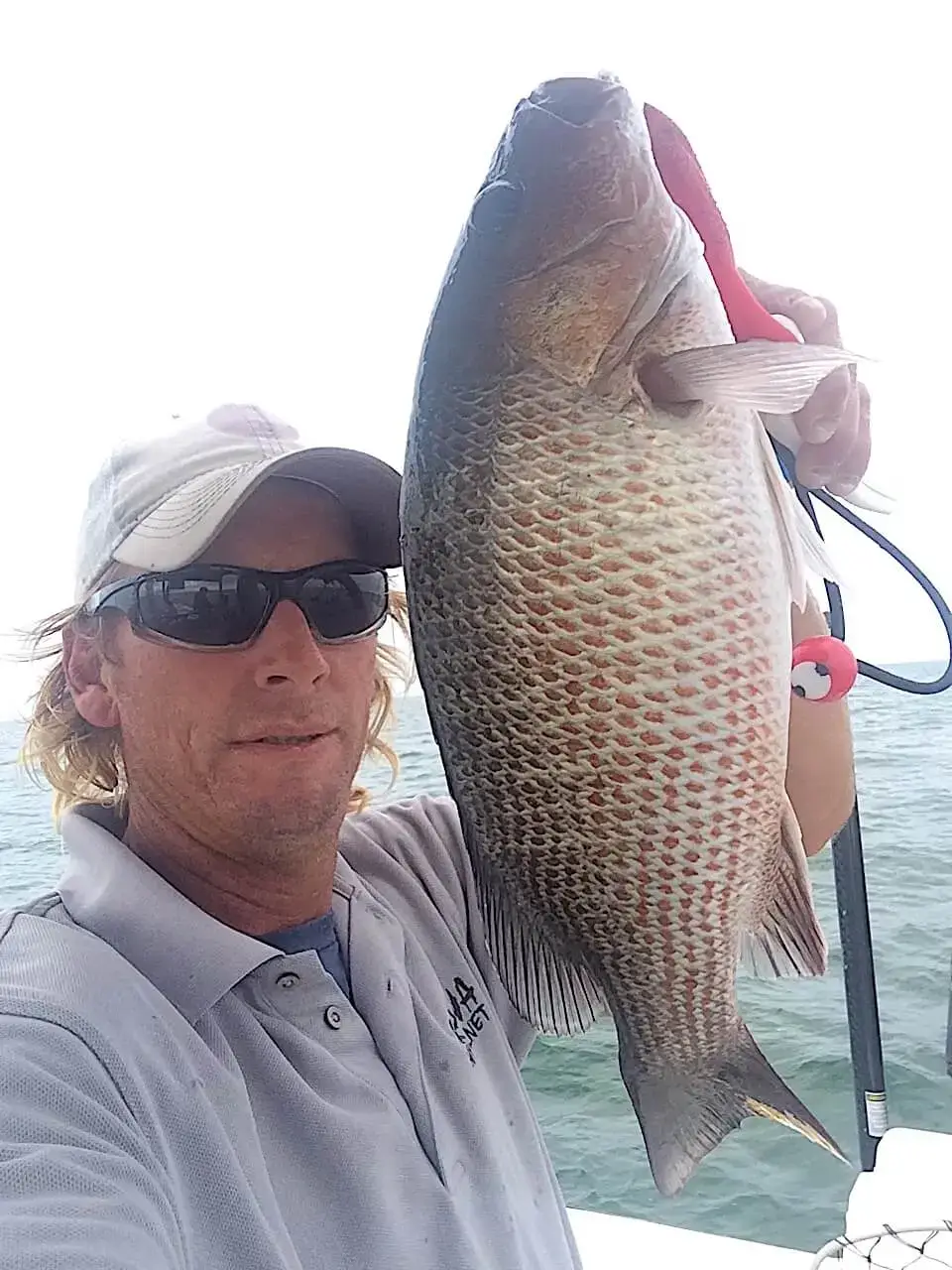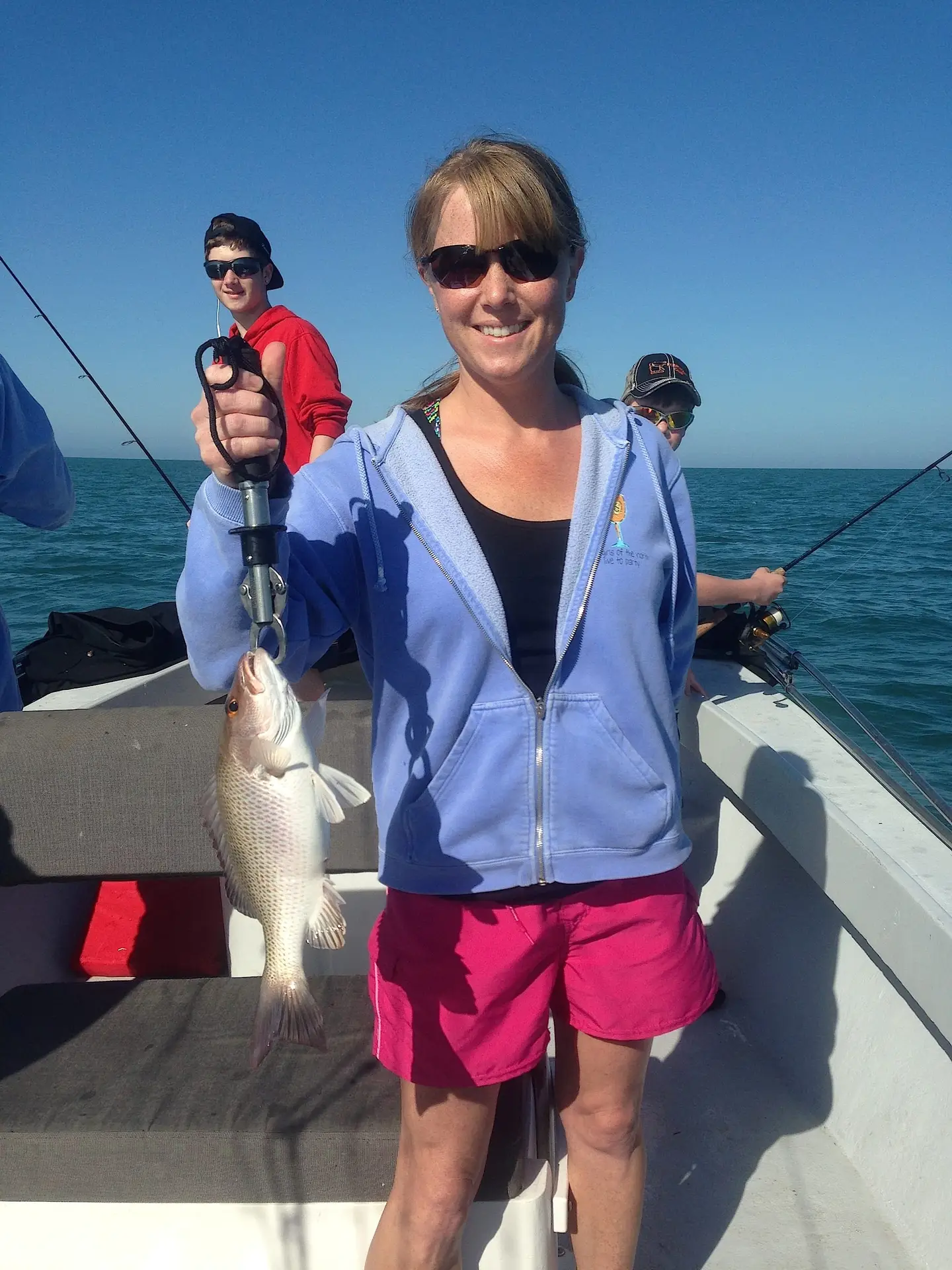![Schoolmaster Snapper, Sanibel Fishing & Captiva Fishing, Sanibel Island, Thursday, January 11, 2018, [File Photo - Thursday, December 28, 2017].](https://captivafishing.net/wp-content/uploads/2017/12/Snapper-Schoolmaster-12-28-17-e1514548292345.webp)

Sanibel Fishing & Captiva Fishing, December 28, 2017: Schoolmaster Snapper!
 Captiva Fishing Report, Thursday, December 28: Schoolmaster Snapper & Grouper, Offshore Structure, Catch & Release; Red Tide Report (Caloosahatchee freshwater runoff may be lessening a bit; some Red Tide but it has broken up and largely dispersed); more fishing reports from other areas and Captains below.
Captiva Fishing Report, Thursday, December 28: Schoolmaster Snapper & Grouper, Offshore Structure, Catch & Release; Red Tide Report (Caloosahatchee freshwater runoff may be lessening a bit; some Red Tide but it has broken up and largely dispersed); more fishing reports from other areas and Captains below.
Thursday, December 28: Snapper & Grouper, Structure, Offshore; Pompano & Bluefish schools running inshore, Snook in the passes, Seatrout on grass flats, Redfish on oyster bars, and Grouper on the structure.
Please also visit the Sanibel, Fort Myers, Florida Fishing Report and Cuban Fishing sites. Better water moving north of Sanibel up through Captiva & North Captiva.
Please click here to Book A Charter or call 239-472-8658 and here for Live Sanibel Traffic Cams.

The schoolmaster snapper (Lutjanus apodus) is a colorful, subtropical fish found over coral reef areas along the coasts of Florida, the Bahamas, and the Caribbean, though it can range northward along the Atlantic coast of the United States.[1] Adults are 12–14 in (30–35 cm) long and weigh 1.0–2.0 lb (0.4–0.8 kg), though rare individuals can weigh 8 lb at 24 in long.
It has a robust, slightly compressed body, with a pointed head. Its color varies from silvery to bronze. Fins and tails are yellow and the snout contains blue stripes. As the common name suggests, schoolmaster snapper live in groups of dozens of subjects. They keep a short distance from the seafloor at depths between 10 and 90 ft, prefer the cover provided by coral reefs during the day, and expand their range to seagrass beds at night. The schoolmaster snapper is sometimes called the barred snapper or the caji. Like other snapper species, it is a popular food fish.

The schoolmaster snapper is found in coastal areas of Florida, the Bahamas, and the Caribbean. It lives in shallow, clear, warm, coastal waters over coral reefs, sand with plants, and mud in mangrove areas or other reef-associated bottom types. Juveniles stay over sand bottoms with or without seagrasses, and over muddy bottoms of lagoons or mangrove areas. The young tend to be in littoral (shore) areas, grass plains and from time to time enter briny waters. They may be seen resting in accumulations during the day. The groups of juveniles in shallow coastal waters, as they grow, move into deeper and deeper water. Large schools are often noticed by divers over shallow wrecks and certain coral patches, and this behavior inspired the common name.

Adults usually stay near shore at depths ranging from 0 to 200 ft (2–60 m) and shelter around elkhorn and gorgonian coral. Large adults are sometimes found on the continental shelf. Typical depths are up to 12 ft (4 m).[2] reported that at night, schoolmaster snapper may increase their range to twice the daytime range, mostly by visiting seagrass beds.

The schoolmaster snapper has a husky, moderately deep body with a pointed head. Its thickness can be more than a third of its standard length. The head is large, and as long as the body is thick; the representation is straight from snout to the backside, and regularly curved to the large, unforked tail. Its triangular snout is long and pointed, with a large mouth. One of the upper pairs of canine teeth is clearly larger than back teeth in the lower jaw and can be seen when the mouth is closed. There are 40 to 45, usually 42 to 44, tubed scales in the lateral line. The interior scale rows on the back are parallel to lateral line.

The soft dorsal and anal fins have scales. The single dorsal fin has 10 spines and 14 soft rays; the spiny portions of the fin are not deeply engraved at the junction with the soft portion. The anal fin has three spines and eight soft rays that are rounded from the tail. The caudal fin is emarginated. The 16 or 17 rays of the pectoral fins are longer than the distance from the longest point of the snout to tail edge of preopercle, reaching the level of anus.

The color is olive gray to brownish on upper back and upper sides, with yellow to reddish mite around the head. The lower sides and belly are lighter; there is no dark lateral spot below the anterior part of the soft dorsal fin. There are 8 narrow, light vertical bars on the side of the body which may be faded or absent in large adults. A solid or broken blue line runs beneath the eye; it may also disappear with growth. From the upper jaw to the tip of the fleshy opercle, the line is often broken into parts that resemble dashes and spots. The fin and tail is bright yellow, yellow-green, or pale orange, and the snout contains blue stripes.

Rooker reported the diet of small L. apodus (<70 mm) consisted of crustaceans (more than 90%), specifically amphipods and crabs. Larger schoolmaster snapper preferred smaller fish (more than 50% by weight) and also ate crabs, shrimp, and stomatopods. He attributed the difference in eating habits to the fact that the bigger fish could open their jaws wider for bigger prey.[3]
Schoolmaster snapper are gonochorist, meaning males and females are separate. They spawn over most of the year, with the majority of the spawning happening during middle to late summer. They spawn during April–June off Cuba. They reproduce by spawning in open water with both male and female fish releasing their gametes at the same time. The fertilized eggs then settle to the bottom, where they are left unguarded.

Most mature schoolmaster snapper average a pound (0.4 kg) or less in shallow water. Big individuals on the deep reefs may reach six or seven pounds. They can grow up to 8 lb and 24 in (62 cm) long, but individuals 12–14 inches (35 cm) long are more commonly observed.
Weight: length relationship for schoolmaster snapper L. apodus[4]
As fish grow longer, they increase in weight, but the relationship is not linear. The relationship between length (L) and weight (W) for nearly all species of fish can be expressed by an equation of the form:
Invariably, b is close to 3.0 for all species, and c varies between species. A weight-length relationship based on 100 schoolmaster snapper ranging in length from 2 to 7 in (50 mm to 180 mm) found the coefficient c was 0.000050015 and the exponent b was 2.9107. This relationship suggests a 12.5-inch schoolmaster snapper (320 mm) will weigh about 2.2 lb (1 kg).[4]

Schoolmaster snapper, along with other snapper species, are sought by both recreational and commercial fishermen. Their food quality is reported to be excellent.
Fishing regulations in US state waters are specific to each state, but they have similarities. For example, the minimum length in Florida for schoolmaster snapper is 10 in (about 25 cm) total length with a catch limit of 10 per fisherman per day. However, the 10-fish limit is an aggregate for all species of snapper.[5]Louisiana and South Carolina have similar limits except the minimum length is 12 in (about 30 cm) total length, and non-stainless steel circle hooks and natural bait are required.[6] These regulations are consistent with current US guidelines for schoolmaster snapper caught in federal waters.[7] The guidelines change from time to time. In certain marine protected areas,[8] fishing is not allowed to help specific species maintain or recover healthy populations.

Light spinning and baitcasting tackle are used to fish for schoolmaster snapper. Live shrimp and baitfish, as well as shrimp pieces and cut bait, are the best natural bait. While jigs make for the best artificial bait, artificials are rarely used and rarely successful.
Larger schoolmaster snapper whose white vertical bars are faded might be mistaken for dog snapper. The schoolmaster, however, does not have the white cone-shaped patch on the gill that identifies the dog snapper. Though different in appearance, schoolmaster snapper have habits similar to those of the mangrove snapper. Please see more information here.

Please click here to Book A Charter or call 239-472-8658 and here for Live Sanibel Traffic Cams. Redfish, Click here for College Of Fishing Hats & Apparel.
We’re located in Castaways Marina, Santiva, Sanibel Island, just before the Blind Pass bridge to Captiva Island.

After a fierce storm, Turner Beach, the beach adjoining the Pass, is frequently covered with a bounty of shells from Olives to Fighting Whelks to the more common Conchs. The fishing is also renowned for sharks in the summer, tailing redfish on the bayside flats and snook under and off the Blind Pass bridge. Because Turner Beach faces Westward, the sunsets are spectacular and a popular viewing point for residents and visitors alike.

And you can like us on Facebook.
Fair winds and following seas,
Captain Joey Burnsed ~ please click calendar at the upper left or call 239-472-8658 to book a Sanibel & Captiva Islands, Boca Grande or Fort Myers fishing guide trip or shelling charter.







